 Millennial are looking for flexibility, affordability, walkability and technology, says Lee & Associates' Todd Braun.
Millennial are looking for flexibility, affordability, walkability and technology, says Lee & Associates' Todd Braun.
PHOENIX—Affordability and a healthy return on investments are just two of the reasons why younger renters and diversifying investors are migrating to multifamily opportunities in secondary markets. Arguably no metro in the country exemplifies these trends more than Phoenix. Just ask Todd Braun, the principal at Lee & Associates, Arizona. Actually, you don't have to. We did. And in this exclusive interview, he told GlobeSt.com.
GlobeSt.com: So let's start with the macro picture. What's the headline in the Southwest multifamily market?
Todd Braun: We're seeing a bit of bifurcation in the Southwest as a whole. On one hand, there's Phoenix and Las Vegas, which have seen occupancy and rent growth that are among the best in the country. That's the product of a healthy market, with both job and population growth and keeping construction in check.
Phoenix, in particular, is seeing a growing wave of employers and investors who are leaving California and heading to Arizona. This can be partially attributed to the state's more favorable business environment, with lower wages and taxes, cheaper energy costs, and more affordable land, housing, and commercial lease rates.
Now, it should be said that this wasn't always the case. In the 1980s and '90s, Phoenix and Vegas were notorious boom-and-bust markets. It was common to see an influx of developers and new construction during strong periods in the market cycle, subsequently the economy would turn bearish while a large number of new multifamily deliveries were hitting the market. The net result was a precipitous drop in apartment market fundamentals.
But today, in this cycle, Phoenix and Las Vegas are doing very well. In fact, they're outpacing the next closest market, which is Atlanta. The rental growth rate there is about five percent. The national average is three. But Phoenix and Vegas are approaching eight percent rent growth. One of the differences during our current cycle is that new construction has stayed close to or below demand levels.
GlobeSt.com: Let's dig a little deeper into the out-migration from California. How is it impacting employment?
Braun: There's a decent amount of employers that don't want to be located in California any longer because of the factors we mentioned. Phoenix has benefited from this outflow, partially because of geographic proximity and also due to the pro business environment of Arizona. Metro Phoenix added 70,000 jobs last year and roughly 100,000 in population growth, which again is among the top in the country.
GlobeSt.com: How would you rank Phoenix among Southwestern cities?
Braun: It's clearly the leader, as every metric bears out. We've grown from a very homogenous employment base in the '80s, when it was fueled largely by construction and hospitality, to one that's very diverse. Technology is a big component of that, as is bio-science, manufacturing and distribution, especially in Western Phoenix, which–like Atlanta–is being recognized as a distribution hub. Healthcare, hospitality, tourism, and construction also figure in diversifying the employment base here.
GlobeSt.com: Call centers also figure largely in that mix, yes?
Braun: We also have a strong call-center and data-center presence. We're immune to some of the natural disasters that other US regions poses such as hurricanes, wildfires, and earthquakes, therefore, call centers, which don't have the luxury of downtime, are drawn here. Other significant factors are the affordability of land and availability of employment at comparatively lower wage rates.
GlobeSt.com: What submarkets are the strongest?
Braun: Again, the city has grown in a very healthy and robust fashion. On an overall basis we'll probably build a total of 7,000 multifamily units this year, and we've absorbed approximately 9,500 units in the past year. But, of course, there are different dynamics in place depending on where you plan to relocate. The South central and Western submarkets tend to attract workforce housing, and that saw the highest rent growth rate nationally last year. And there's been minimal new construction to dilute the dynamics of the market.
In part, that's because single-family builders are moving away from entry-level housing due to the lack and rising cost of labor, the material costs and margins that tend to be higher in more expensive home builds. This too helps multifamily, especially for millennials and others on the lower economic scale who need more affordable product.
In terms of specific locales, The Downtown Phoenix submarket possibly has the weakest fundamentals currently due to a wave of new construction in the area but it should be short lived due to a deep pool of nearby employment and tenant generators. It rates very high in terms of millennial influence with both college students and grads, especially since the University of Arizona and Arizona State University both have Downtown campuses.
Anywhere that provides walkability tends to do well. Scottsdale certainly as well as Downtown Gilbert, which has seen a real vibrant redevelopment of its Downtown Historic District.
GlobeSt.com: And, of course, millennials are key to any market's viability.
Braun: Millennials are a huge component nationally and in Phoenix. In the '80s and '90s, there was a real desire for two-bedroom, two-bath units. Today studios and ones are doing fantastic, which has to do with the millennial influx. They're looking for flexibility and affordability. They're also looking for amenities, walkability and technology.
In all, institutional and private investors are chasing returns. Phoenix is one of the top return markets in the country. Interest rates on acquisition financing keep inching down, and that continues to spur transaction volume. If I were to look back at previous cycles, a lot of our price appreciation was more a function of cap-rate compression. In this cycle it tends to be the result of a much healthier valuation due to a strong and improving operational environment, as well as all of the factors we discussed.
© 2025 ALM Global, LLC, All Rights Reserved. Request academic re-use from www.copyright.com. All other uses, submit a request to [email protected]. For more information visit Asset & Logo Licensing.








